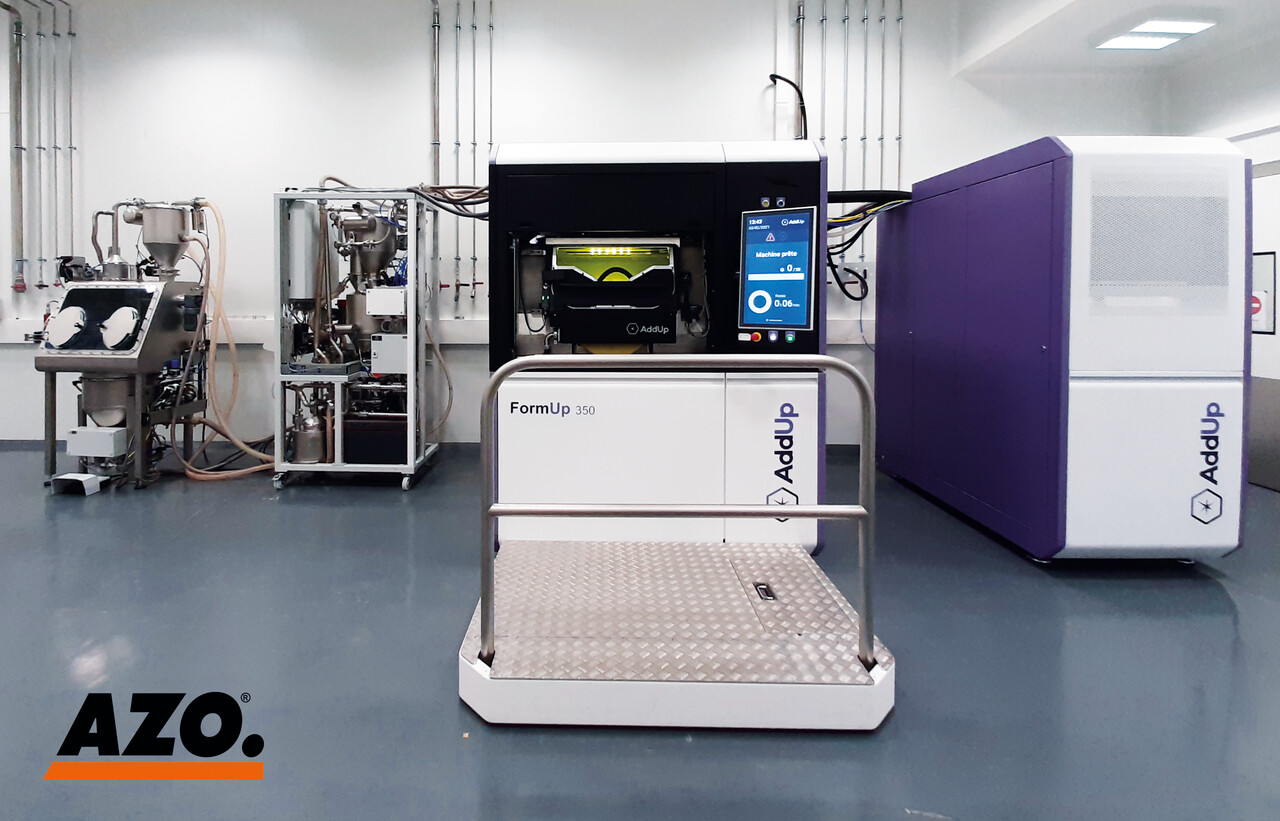Metal powders are some of the most finicky materials in the 3D printing industry in that, not only do the metal particles require a high level of consistency, sphericity, and small size range for powder bed fusion (PBF), but every metal is quite different from one another. Moreover, many can be toxic or even highly explosive.
For this reason, handling metal powders is no easy task, typically requiring elaborate systems with inert gas environments to depowder parts and prepare subsequent builds, all within a well-regulated facility. To ease the burdens of this costly, labor-intensive and sometimes dangerous process, French 3D printing company AddUp teamed up with the AZO Group to develop a fully automated powder handling and feeding system for metal 3D printing.
AZO is a €167 million German company with offices across seven countries. It is dedicated to the automation of raw materials processing. For this reason, AddUp, an entity started by Michelin and the Fives Group, turned to AZO France for a customer-specific solution for an inert metal powder handling solution for feeding the material to a 3D printer. This led to the development of a production-ready powder supply system in 2019 that further led to versions that could be adaptable to the variety of machines supplied by AddUp.
The fully automated system was meant to feed raw material continuously to the printers to prevent downtime, while also discharge excess powder from the print job, as well as process the unsintered excess material, screen it, and then feed it back into the system. And it was meant to do this all while keeping the operator as safe as possible.
The resulting solution features three modules: material supply and preparation; material conveying, and the printer feeder itself. The first area features a sealed and inert GloveBox where new powder is supplied via small containers and fed by a vacuum to a screening module. There it undergoes ultrasonic screening specifically developed for metal powder.
Next, the material is fed in the proper quality, quantity and rate of time via vacuum conveyor to the printer. There, it is transferred to the printer in the correct quantity. Excess material from previous builds is removed, centrally collected in a container and transferred pneumatically to the initial screening module, where it is sieved, processed and brought into the closed-loop production cycle. AZO notes that the system can be designed for different material inputs and the number of printers. It can be scaled from small systems for a single printer to “collective feeding of entire printing factories.”
Necessary to the solution is a control system, which includes a web-based user interface and the ability to access the AZO powder module from the 3D printer itself. The system is further able to recognize which modules are available and automatically activate or deactivate the based on the operation.
Safety features include the fact that the operator is never exposed to the metal materials directly and a failsafe that shuts down all affected functions if a hot-connect module fails, while all unaffected areas continue to operate.
The company summarizes its capabilities as follows:
- “Continuous production without interruption of the material flow.
- Customized screening technology for a wide range of particle sizes
- Explosion protection of the entire system according to current explosion protection guidelines
- Inert gas and protective gas atmosphere ensures product safety
- Intelligent control technology and visualization”
It’s interesting to see this level of automation being delivered for metal 3D printing. It’s particularly noteworthy that this system could be applied to an entire factory. Meanwhile, numerous metal 3D printer manufacturers claim to be working on automated powder handling solutions, such as Concept Laser and 3D Systems, while Additive Industries already includes some automation in its MetalFab series.
AddUp is seeking to become an all-encompassing metal 3D printing provider, offering both laser PBF and directed energy deposition machines, as well as printing services and the engineering expertise required to apply all of the above to specific customer applications. If it happened to brand and sell AZO powder handling equipment, it would be well on its way to tackling all aspects of the metal 3D printing space, leaving only post-processing of metal parts to be not dealt with.
These trends are discussed in much greater depth in the recent “Automation, Additive Manufacturing and the Factory of the Future” report from SmarTech Analysis.
Subscribe to Our Email Newsletter
Stay up-to-date on all the latest news from the 3D printing industry and receive information and offers from third party vendors.
You May Also Like
HP & INDO-MIM Collaborate to Boost Metal 3D Printing in India
HP Inc. and INDO-MIM, a US- and India-based supplier of metal injection molding (MIM) powders and contract manufacturer, have announced that the two companies will collaborate to accelerate additive manufacturing...
New Report: Semiconductor Industry to See $1.4B in 3D Printing Revenues by 2032
“The semiconductor sector has become the most strategically significant area of global industry.” Truer words are hard to come by when it comes to the modern world, and they are...
One of US’s Largest Machine Tool Resellers to Offer Stratasys 3D Printing
In a key move for the additive manufacturing (AM) stalwart, Stratasys (Nasdaq: SSYS) has announced a strategic partnership with Select Additive Technologies, a division of Morris Group, Inc., which is...
3D Printing Unpeeled: Orbex Investment, IndoMIM and HP, Ultrasonic Waves
INDO-MIM has bought three HP Metal Jet S100 printers, operating two in India and one in Texas. This is a win for HP because the company has deep experience in...































